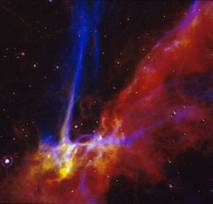Origin of the solar system
We understand a lot more about the circumstances surrounding the origin and the evolution of our solar system by studying meteorites. For example, isotopic analysis of elements in meteorites teaches us about the chemical composition of the protosolar nebula. The discovery of sulfur-36 in a carbonaceous chondrite confirmed that a supernova played a role in the birth of the solar system. Sulfur-36 is produced by the transformation of chlorine-36. But there is no chlorine-36 in our solar system today, because the Sun does not manufacture it. Chlorine-36 must have been created during the violent explosion of a supernova. The explosion had to occur close to the protosolar nebula, and it accelerated the collapse that led to the birth of our star, the Sun, and its procession of planets.
 |
| Enlargement |
| The Swan Nebula, remains of the explosion of a supernova type star, captured by the Hubble space telescope. |
|